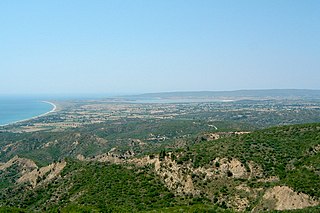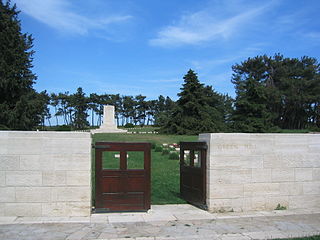Related Research Articles

The Gallipoli campaign was a military campaign in the First World War that took place on the Gallipoli peninsula, from 19 February 1915 to 9 January 1916. The Entente powers, Britain, France and Russia, sought to weaken the Ottoman Empire, one of the Central Powers, by taking control of the Ottoman straits. This would expose the Ottoman capital at Constantinople to bombardment by Allied battleships and cut it off from the Asian part of the empire. With Turkey defeated, the Suez Canal would be safe and a year-round Allied supply route could be opened through the Black Sea to warm-water ports in Russia.
The Battle of Sari Bair, also known as the August Offensive, represented the final attempt made by the British in August 1915 to seize control of the Gallipoli peninsula from the Ottoman Empire during the First World War.

The Battle of Hill 60 was the last major assault of the Gallipoli Campaign. It was launched on 21 August 1915 to coincide with the attack on Scimitar Hill made from the Suvla front by Major-General H. de B. De Lisle's British IX Corps, Frederick Stopford having been replaced in the few days previous. Hill 60 was a low knoll at the northern end of the Sari Bair range which dominated the Suvla landing. Capturing this hill along with Scimitar Hill would have allowed the Anzac and Suvla landings to be securely linked.
The Battle of Scimitar Hill was the last offensive mounted by the British at Suvla during the Battle of Gallipoli in World War I. It was also the largest single-day attack ever mounted by the Allies at Gallipoli, involving three divisions. The purpose of the attack was to remove the immediate Ottoman threat from the exposed Suvla landing and to link with the ANZAC sectors to the south. Launched on 21 August 1915 to coincide with the simultaneous attack on Hill 60, it was a costly failure, in which the Turks were forced to use all their reserves in "severe and bloody fighting" far into the night, with some Turkish trenches lost and retaken twice.

Lance Sergeant William Stephen Kenealy VC, was an Irish recipient of the Victoria Cross, the highest and most prestigious award for gallantry in the face of the enemy that can be awarded to British and Commonwealth forces.

Brigadier General Paul Aloysius Kenna, VC, DSO was an English-born British Army officer of Irish descent and recipient of the Victoria Cross (VC), the highest and most prestigious award for gallantry in the face of the enemy that could be awarded to British and British Empire forces. He also competed at the 1912 Summer Olympics.

Gerald Robert O'Sullivan VC was an Irish recipient of the Victoria Cross, the highest and most prestigious award for gallantry in the face of the enemy that can be awarded to British and Commonwealth forces.

The landing at Suvla Bay was an amphibious landing made at Suvla on the Aegean coast of the Gallipoli peninsula in the Ottoman Empire as part of the August Offensive, the final British attempt to break the deadlock of the Battle of Gallipoli. The landing, which commenced on the night of 6 August 1915, was intended to support a breakout from the ANZAC sector, five miles (8 km) to the south.

Azmak Cemetery near Suvla Bay, Gallipoli, Turkey was constructed shortly after the end of the First World War by the Commonwealth War Graves Commission and filled with graves brought in from small cemeteries and sites around it. It is on the south side of Azmak Dere, from which it takes its name, a small ravine which runs into the salt lake at Suvla Bay. Special memorials record the names of 53 British and 3 Newfoundland soldiers buried in the cemetery but whose graves are not positively identified.

Green Hill Cemetery is a Commonwealth War Graves Commission cemetery located near Suvla Bay, Gallipoli, Turkey.
Walker's Ridge Cemetery is a small Commonwealth War Graves Commission cemetery located near Suvla Bay in Turkey. It contains the remains of Allied soldiers killed during the Battle of Gallipoli.
Shell Green Cemetery is a Commonwealth War Graves Commission Cemetery from World War I in the former Anzac sector of the Gallipoli Peninsula, Turkey for soldiers killed during the Gallipoli campaign. The eight-month campaign was fought by Commonwealth and French forces against Turkish forces in an attempt to force Turkey out of the war, to relieve the deadlock of the Western Front (France/Belgium) and to open a supply route to Russia through the Dardanelles and the Black Sea.
Hill 10 Cemetery is a Commonwealth War Graves Commission Cemetery in the former Suvla Bay sector of the Gallipoli Peninsula, Turkey. The battles at Gallipoli, some of whose participating soldiers are buried at this cemetery, was an eight-month campaign fought by Commonwealth and French forces against Turkish forces in an attempt to force Turkey out of the war, to relieve the deadlock of the Western Front (France/Belgium) and to open a supply route to Russia through the Dardanelles and the Black Sea.

Hill 60 Cemetery is a Commonwealth War Graves Commission cemetery dating from World War I at the Northern end of the former Anzac sector of the Gallipoli Peninsula, Turkey and the location of Hill 60 Memorial, one of four memorials on the peninsula which commemorate New Zealanders killed in the campaign but who have no known grave.

Johnston's Jolly Cemetery is a Commonwealth War Graves Commission cemetery containing the remains of some of the Allied troops who died during the Battle of Gallipoli.

Courtney's and Steel's Post Cemetery is a Commonwealth War Graves Commission cemetery located near ANZAC Cove on the Gallipoli peninsula in Turkey. It contains the graves of some of the former British Empire troops who died during the Gallipoli Campaign.

Lone Pine Cemetery is a Commonwealth War Graves Commission cemetery dating from World War I in the former Anzac sector of the Gallipoli Peninsula, Turkey and the location of the Lone Pine Memorial, one of five memorials on the peninsula which commemorate servicemen of the former British Empire killed in the campaign but who have no known grave.

The Helles Memorial is a Commonwealth War Graves Commission war memorial near Sedd el Bahr, in Turkey, on the headland at the tip of the Gallipoli peninsula overlooking the Dardanelles. It includes an obelisk which is over 30 metres (98 ft) high.
Andrew Bowie McCrae was a Scottish professional footballer who played in the Scottish League for Queen's Park and Falkirk as an outside right.
References
- ↑ Davies & Maddocks 1995 , p. 80